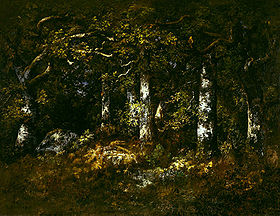French Landscape Painting
French landscape Painting
Even as landscapes became acceptable as subjects in the 17th century, they were still often created merely as settings for biblical, mythological, or historical scenes. The classical landscape was perfected by French artists Nicolas Poussin and Claude Lorrain. French painter Jean-Baptiste-Camille Corot and painters in the Barbizon School established a French landscape tradition. It became the most influential in Europe for a century with the Impressionists and Post-Impressionists; for the first time landscape painting would become the main source of innovation across all genre of painting. The influence of the Revolutionary artist Gustave Courbet extended well beyond Impressionism, impacting the work of Paul Cézanne and Vincent Van Gogh, as well as painters in the 20th century. [1]
From the French masters
Theodore Rousseau, Pond at the Edge of a Wood.
Paul Cezanne, Bord de la Marne, 1888.
Claude Lorrain, Pastoral landscape with Lake Albano and Castel Gandolfo, 1639.
Nicolas Poussin, Landscape with a Calm, 1650-1651.
Camille Corot, Road to Sèvres, 1855-1865.
Gustave Courbet, Château d’Ornans, 1855.
The Beach at Sainte-Addresse by Jean-Frédéric Bazille, 1865.
Edgar Degas, Sea landscape with sandy beach at low tide, 1869.
Alfred Sisley, Thames at Hampton Court, 1874.
Pierre-Auguste Renoir, Paysage de Neige, 1870-1875.
Claude Monet, Landscape At Vetheuil, 1880.
Claude Monet, Landscape near Montecarlo, 1883.
Claude Monet, Banks of the Seine at Jeufosse Clear Weather, 1884.
Paul Gauguin, Boy by the Water, 1885.
Paul Gauguin, Landscape Farmhouse in Arles, 1888.
Paul Gauguin, Breton Boy by the Aven River, 1888.
Armand Guillaumin, Mountainous landscape, 1895.
Eugene Boudin, Etretat, la falaise Amont, 1896.
Pierre Bonnard, Dauphine Landscape, 1899.
Alfred Sisley, Langland Bay, Storr's Rock - Morning, 1897.

Between 1800 and 1900, French landscape painting underwent a remarkable transformation from a minor genre rooted in classical traditions to a primary vehicle for artistic experimentation... This emphasis on timeless landscapes augmented with historical vignettes persisted into the first decades of the nineteenth century, when the Neoclassical landscape painter Pierre-Henri de Valenciennes worked within the Academy to establish a Prix de Rome honoring "historical landscape" painting, first awarded in 1817. [2] In 1800, Valenciennes published a groundbreaking book on landscape painting, Eléments de perspective practique. [3]

Corot is the best-known 19th-century French landscape painter before Monet and perhaps the most influential of all 19th-century French landscape painters. [4]
- Renoir, View From Cap Martin of Monte Carlo, 1884.
See also

MAKING ART WITH ART
























